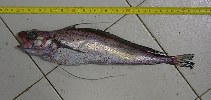Add your observation in Fish Watcher
| Native range | All suitable habitat | Point map | Year 2050 |

|
| This map was computer-generated and has not yet been reviewed. |
| Phycis chesteri AquaMaps Data sources: GBIF OBIS |
Upload your photos and videos
Pictures | Google imagePhycis chesteri
Picture by Garazo Fabregat, A.
Pictures | Google imagePhycis chesteri
Picture by Garazo Fabregat, A.
Common names from other countries
Classification / Names Common names | Synonyms | Catalog of Fishes(genus, species) | ITIS | CoL | WoRMS | Cloffa
Teleostei (teleosts) > Gadiformes (Cods) > Phycidae (Phycid hakes)
Etymology: Phycis: Taken from Greek, phykon = seaweed; because of the habits of this fish that lives hidden among them (Ref. 45335).
Eponymy: Captain Hubbard C Chester (1836–1886) made a number of whaling voyages before being appointed sailing master of the Arctic exploring steamer Polaris (1871). [...] (Ref. 128868), visit book page.
More on authors: Goode & Bean.
Etymology: Phycis: Taken from Greek, phykon = seaweed; because of the habits of this fish that lives hidden among them (Ref. 45335).
Eponymy: Captain Hubbard C Chester (1836–1886) made a number of whaling voyages before being appointed sailing master of the Arctic exploring steamer Polaris (1871). [...] (Ref. 128868), visit book page.
More on authors: Goode & Bean.
Environment: milieu / climate zone / depth range / distribution range Ecology
Marine; benthopelagic; non-migratory; depth range 90 - 1500 m (Ref. 40643), usually 360 - 800 m (Ref. 1371). Temperate; 61°N - 24°N, 81°W - 40°W
Distribution Countries | FAO areas | Ecosystems | Occurrences | Point map | Introductions | Faunafri
Western Atlantic: Canada to straits of Florida, found in the outer continental shelves and slopes, but not abundant to south of Cape Hatteras.
Size / Weight / Age
Short description Identification keys | Morphology | Morphometrics
Dorsal spines (total): 0; Anal spines: 0. Dorsal fin with an extremely elongated ray, its length longer than head length. Longest pelvic-fin ray reaching beyond the posterior end of the anal-fin base. Olive on sides, belly pale; the margins of the dorsal, caudal and anal fins darker.
Epibenthic (Ref. 58426). Minimum depth at 90 m (Ref. 1371). Most abundant between 360 and 800 m. Feeds mostly on crustaceans (especially euphausiids, shrimps and amphipods (Ref. 5951)) but also on mollusks and fishes (Ref. 1371).
Life cycle and mating behavior Maturity | Reproduction | Spawning | Eggs | Fecundity | Larvae
Main reference
Upload your references | References | Coordinator | Collaborators
Cohen, D.M., T. Inada, T. Iwamoto and N. Scialabba, 1990. FAO species catalogue. Vol. 10. Gadiform fishes of the world (Order Gadiformes). An annotated and illustrated catalogue of cods, hakes, grenadiers and other gadiform fishes known to date. FAO Fish. Synop. 125(10). Rome: FAO. 442 p. (Ref. 1371)
Threat to humans
Harmless
Human uses
Fisheries: of potential interest
FAO(Publication : search) | FishSource | Sea Around Us
More information
Population dynamics
Growth parameters
Max. ages / sizes
Length-weight rel.
Length-length rel.
Length-frequencies
Mass conversion
Recruitment
Abundance
Growth parameters
Max. ages / sizes
Length-weight rel.
Length-length rel.
Length-frequencies
Mass conversion
Recruitment
Abundance
Anatomy
Gill area
Brain
Otolith
Gill area
Brain
Otolith
Physiology
Body composition
Nutrients
Oxygen consumption
Swimming type
Swimming speed
Visual pigments
Fish sound
Diseases & Parasites
Toxicity (LC50s)
Body composition
Nutrients
Oxygen consumption
Swimming type
Swimming speed
Visual pigments
Fish sound
Diseases & Parasites
Toxicity (LC50s)
Genetics
Genetics
Heterozygosity
Heritability
Genetics
Heterozygosity
Heritability
Human related
Aquaculture systems
Aquaculture profiles
Strains
Ciguatera cases
Stamps, coins, misc.
Aquaculture systems
Aquaculture profiles
Strains
Ciguatera cases
Stamps, coins, misc.
Tools
E-book | Field guide | Identification keys | Length-frequency wizard | Life-history tool | Point map | Classification Tree
| Catch-MSY |
Special reports
Download XML
Internet sources
Aquatic Commons | BHL | Cloffa | Websites from users | Check FishWatcher | CISTI | Catalog of Fishes(genus, species) | DiscoverLife | ECOTOX | Faunafri | Fishtrace | GenBank(genome, nucleotide) | GloBI | GOBASE | | Google Books | Google Scholar | Google | IGFA World Record | MitoFish | Otolith Atlas of Taiwan Fishes | PubMed | Reef Life Survey | Scirus | SeaLifeBase | Tree of Life | Wikipedia(Go, Search) | World Records Freshwater Fishing | Zoobank | Zoological Record
Estimates based on models
Preferred temperature (Ref. 115969): 2.9 - 5.7, mean 4.1 (based on 56 cells).
Phylogenetic diversity index (Ref. 82804): PD50 = 0.6255 [Uniqueness, from 0.5 = low to 2.0 = high].
Bayesian length-weight: a=0.00380 (0.00183 - 0.00790), b=3.12 (2.93 - 3.31), in cm Total Length, based on LWR estimates for this (Sub)family-body shape (Ref. 93245).
Trophic level (Ref. 69278): 3.2 ±0.0 se; based on diet studies.
Resilience (Ref. 120179): Low, minimum population doubling time 4.5 - 14 years (Preliminary K or Fecundity.).
Fishing Vulnerability (Ref. 59153): Moderate to high vulnerability (55 of 100).




